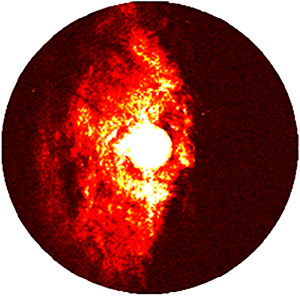Protection of coherent pulse radars against combined interferences. 2. Analysis of influence of decorrelating factors on efficiency of adaptive sequential STSP
DOI:
https://doi.org/10.3103/S0735272721110017Keywords:
space-time signal processing, fluctuations of random estimate, combined interference, STSP, weight vector estimate, random estimate fluctuations, non-classified training samples, energy lossesAbstract
This is the second paper in a series of articles devoted to modern methods of protection of coherent-pulse radars against the combined interference (i.e., an additive mixture of internal noise, masking clutter and noise jamming). Quantitative analysis of the influence of decorrelating factors on the efficiency of sequential adaptive systems with separate space-time signal processing (STSP) against the background of combined interference has been performed under conditions when the spatial processing with noise jamming compensation precedes the inter-period processing with clutter compensation. The analysis-based values of energy losses during the fluctuations of the random estimate of the spatial processing weight vector obtained for each sounding period over the limited size classified sample of noise jamming confirm the need to fix (store) this vector for the period of the inter-period clutter compensation. It is shown that the additional lack of classification of the training sample of interference increases the energy losses.
References
D. I. Lekhovytskiy, V. P. Riabukha, A. V. Semeniaka, D. V. Atamanskiy, Y. A. Katiushyn, “Protection of coherent pulse radars against combined interferences. 1. Modifications of STSP systems and their ultimate performance capabilities,” Radioelectron. Commun. Syst., vol. 62, no. 7, pp. 311–341, 2019, doi: https://doi.org/10.3103/S073527271907001X.
Y. D. Shirman, S. T. Bagdasaryan, A. S. Malyarenko, D. I. Lekhovitskii, Radio Electronic Systems. Principles of Construction and Theory. Reference Book, [in Russian]. Moscow: Radiotekhnika, 2007.
J. Ward, “Space-time adaptive processing for airborne radar: Technical Report No. 1015,” Massachusetts, 1994. uri: https://apps.dtic.mil/sti/pdfs/ADA293032.pdf.
R. Klemm, Principles of Space-Time Adaptive Processing. Institution of Engineering and Technology, 2006, doi: https://doi.org/10.1049/PBRA021E.
W.-D. Wirth, Radar Techniques Using Array Antennas. Institution of Engineering and Technology, 2013, doi: https://doi.org/10.1049/PBRA026E.
J. R. Guerci, Space-Time Adaptive Processing for Radar, 2nd ed. Artech House, 2014.
W. L. Melvin, “Space-Time Adaptive Processing for Radar,” in Communications and Radar Signal Processing, 2014, pp. 595–665.
C. Wortham, “Space-time adaptive processing for ground surveillance radar,” 2007.
J. Xu, S. Zhu, G. Liao, “Space-time-range adaptive processing for airborne radar systems,” IEEE Sensors J., vol. 15, no. 3, pp. 1602–1610, 2015, doi: https://doi.org/10.1109/JSEN.2014.2364594.
T. Pető, R. Seller, “Space-time adaptive cancellation in passive radar systems,” Int. J. Antennas Propag., vol. 2018, pp. 1–16, 2018, doi: https://doi.org/10.1155/2018/2467673.
V. Navratil, A. O’Brien, J. L. Garry, G. E. Smith, “Demonstration of space-time adaptive processing for DSI suppression in a passive radar,” in 2017 18th International Radar Symposium (IRS), 2017, pp. 1–10, doi: https://doi.org/10.23919/IRS.2017.8008146.
A. I. Perov, S. P. Ippolitov, “Synthesis of an algorithm of space-time processing received satellite navigation signal and spoofing jamming,” J. Sib. Fed. Univ. Math. Phys., vol. 10, no. 4, pp. 429–442, 2017, doi: https://doi.org/10.17516/1997-1397-2017-10-4-429-442.
T. Marathe, S. Daneshmand, G. Lachapelle, “Assessment of measurement distortions in GNSS antenna array space-time processing,” Int. J. Antennas Propag., vol. 2016, pp. 1–17, 2016, doi: https://doi.org/10.1155/2016/2154763.
B. Kang, “Robust covariance matrix estimation for radar space-time adaptive processing (STAP),” Pennsylvania, 2015.
R. Li, J. Li, W. Zhang, Z. He, “Reduced-dimension space-time adaptive processing based on angle-Doppler correlation coefficient,” EURASIP J. Adv. Signal Process., vol. 2016, no. 1, p. 97, 2016, doi: https://doi.org/10.1186/s13634-016-0395-2.
W. Wang, L. Zou, X. Wang, “Research on space-time adaptive processing with respect to the signal powers,” Prog. Electromagn. Res. C, vol. 82, pp. 99–107, 2018, doi: https://doi.org/10.2528/PIERC18011401.
D. M. Piza, V. N. Lavrentiev, D. S. Semenov, “Method of forming of the classified training sample for automatic canceller of the interferences when using time-space filtering of signals,” Radio Electron. Comput. Sci. Control, no. 3, pp. 18–22, 2016, doi: https://doi.org/10.15588/1607-3274-2016-3-2.
D. M. Piza, G. V. Moroz, “Methods of forming classified training sample for adaptation of weight coefficient of automatic interference compensator,” Radioelectron. Commun. Syst., vol. 61, no. 1, pp. 32–37, 2018, doi: https://doi.org/10.3103/S0735272718010041.
D. M. Piza, T. I. Bugrova, V. M. Lavrentiev, D. S. Semenov, “Selector of classified training samples for spatial processing of signals under the impact of combined clutter and jamming,” Radio Electron. Comput. Sci. Control, no. 4, pp. 26–32, 2018, doi: https://doi.org/10.15588/1607-3274-2017-4-3.
D. M. Piza, S. N. Romanenko, D. S. Semenov, “Correlation method for forming the training sample for adaptation of the spatial filter,” Radio Electron. Comput. Sci. Control, no. 3, 2018, doi: https://doi.org/10.15588/1607-3274-2018-3-4.
D. M. Piza, T. I. Bugrova, V. N. Lavrentiev, D. S. Semenov, “Method of forming classified training sample in case of spacial signal processing under influence of combined interference,” Radioelectron. Commun. Syst., vol. 61, no. 7, pp. 325–331, 2018, doi: https://doi.org/10.3103/S0735272718070051.
V. P. Ryabukha, D. S. Rachkov, A. V. Semeniaka, I. A. Katiushyn, “Estimation of spatial weight vector fixation interval for sequential space-time signal processing against the background of combined interferences,” Radioelectron. Commun. Syst., vol. 55, no. 10, pp. 443–451, 2012, doi: https://doi.org/10.3103/S0735272712100020.
V. A. Alebastrov et al., Foundations of Over-the-Horizon Radio Location, [in Russian]. Moscow: Radio i Svyaz’, 1984.
D. M. Piza, A. P. Zalevskii, “Peculiarities of adaptation of spatial filters under exposure to combined interference,” Radio Electron. Comput. Sci. Control, no. 1, pp. 45–48, 2005, uri: http://ric.zntu.edu.ua/issue/view/1594/pdf_19.
I. D. Mai, A. G. Kaspirovich, V. A. Vinnik, A. I. Donchenko, V. N. Motyl, V. G. Antonenko, Radar Station 36D6. Operation Manual and Maintenance, [in Russian]. Zaporizhzhia: Iskra, 2006.
Y. I. Abramovich, “Controlled method for adaptive optimization of filters using the criterion of maximum signal-to-noise ratio,” Radio Eng. Electron. Phys., vol. 25, no. 3, pp. 87–95, 1981.
V. P. Riabukha, A. V. Semeniaka, Y. A. Katiushyn, D. V. Atamanskiy, “Selection of parameters for band-diagonal regularization of maximum likelihood estimates of Gaussian interference correlation matrices and their inverses,” Radioelectron. Commun. Syst., vol. 64, no. 5, pp. 229–237, 2021, doi: https://doi.org/10.3103/S0735272721050010.
V. P. Riabukha, “Adaptive radar noise jamming protection systems. 4. The choice of quantity, structure and arrangement of compensation modules in a radar with a flat PAA,” Appl. Radio Electron., vol. 16, no. 1,2, pp. 3–12, 2017, uri: https://nure.ua/wp-content/uploads/2018/Scientific_editions/are_1.pdf.


